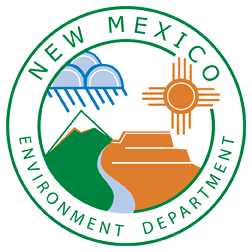Harmful algal blooms (HABs) are overgrowths of algae in water that pose a health risk to people and animals. In New Mexico some cyanobacteria blooms can produce cyanotoxins with a potential to severely affect human and animal health. Cyanobacteria (photosynthetic single-celled microscopic organisms) generally grow in lakes, ponds, and slow-moving streams when water is warm and stagnant. Cyanobacteria are commonly referred to as blue-green algae because they look very similar to algae.
What do HABs look like?
Under normal conditions, cyanobacteria are present in surface waters at low levels and play an important role in aquatic ecosystems. When HABs occur, cyanobacteria become visibly abundant and can look like grass clippings, blue-green scum, or spilled paint on the water surface. Blooms can be blue, bright green, brown or red. HABs may also be suspended in the water column or attached to rocks, sediments, or aquatic plants. Some blooms may not affect the appearance of the water but as algae in the blooms die, the water may smell bad.
How can I tell the difference among cyanobacteria, non-toxic algae, and plants?
Individual cyanobacterial cells are small but can cluster together to form scums or mats. Because cyanobacterial scums or mats are comprised of individual cells, they can be broken-up when disturbed. Algae often form long hair-like networks that cling together when disturbed. Aquatic plants are generally much larger than cyanobacteria, grow attached to the bottom of a waterbody, and have extensive stem, leaf, and root networks.
Why are HABs in recreational waters a health concern?
Cyanobacteria can produce toxins and other irritants that can cause several health effects in people and animals, including pets and livestock. People and animals can be exposed to cyanobacteria and their associated toxins and irritants via skin contact with water or bloom material, breathing in water spray, or ingesting water or bloom material. Health effects include rashes, itching, numbness, fatigue, disorientation, abdominal pain, vomiting, and diarrhea. In extreme cases, cyanotoxins may lead to wildlife, pet or livestock death. Blooms may also cause fish kills due to depleted oxygen levels, create issues for drinking water supplies and agriculture, and lead to tourism and property value losses. To find more information on HCB-related health effects for people and animals, visit the Center for Disease Control and Prevention’s webpage.
Have there been any deaths in New Mexico due to cyanobacteria?
There have been no reported human deaths but there have been several dog deaths. There have been reports of rashes and stomach problems in humans exposed to water with cyanobacteria.
What should we do if we see a HAB and how can I keep people and animals safe?
If you encounter a potential HAB, NMED recommends:
- Avoid contact with water in the vicinity of the bloom, especially in areas where cyanobacteria are dense and form scums.
- Do not ingest water from the bloom. Boiling, filtration and/or other treatments will not remove toxins.
- Rinse fish with clean water and eat only the fillet portion.
- Avoid water spray from the bloom.
- Do not allow pets or livestock to drink water near the bloom, eat bloom material, or lick fur after contact.
- If people, pets, or livestock come into contact with a bloom, rinse off with clean water as soon as possible and contact a doctor or veterinarian.
Practices to protect animals and people from HCBs by restricting access to contaminated water or providing alternative water sources are outlined on the Natural Resources Conservation Service webpage.
What Causes HABs?
Cyanobacteria occur naturally in surface waters, both in the water column as part of the phytoplankton community or attached to substrates such as rocks, sediment, wood, aquatic vegetation, or other surfaces as part of the periphyton community. HABs that develop in the water column (i.e., planktonic HABs) most commonly occur in still or slow-moving surface waters, such as lakes and reservoirs. HABs that develop attached to surfaces form biofilms or mats (i.e., mat-forming HABs) and are most common in wadable streams and rivers but can also be found in lakes, reservoirs, and hot springs. Mat-forming HABs can detach, move downstream, and float to other locations in a waterbody. Wind can also aggregate cyanobacteria. Factors such as sunlight, water clarity, nutrients (e.g., phosphorus and nitrogen), carbon, water velocity and mixing, water temperatures, and consumption by other aquatic organisms can affect the formation of planktonic and mat-forming HABs. Planktonic HABs often form in waterbodies with excess nitrogen and phosphorus. Mat-forming HABs can occur in waterbodies with limited nutrient availability because the cyanobacteria can access nutrients from the substrates and algae, microbes, and inorganic matter that is present within the mat matrix. Nitrogen and phosphorus can enter surface waters from fertilizers, animal waste from pets and livestock, wastewater from treatment plants and septic systems, detergents, stormwater runoff, cars, and fuel-burning power plants.
Where in New Mexico can blue-green algae grow?
Blue-green algae can be found anywhere in New Mexico. Blue-green algae generally grows in lakes, ponds, and slow-moving streams when water is warm and stagnant. In certain locations, conditions are better for algae growth, including shallow coves. However, not all algae is toxic, in fact the vast majority of algae is not dangerous.
If I don’t see any blue-green algae in the water, can I still do all the things I normally do like fishing, swimming, water skiing, and wading?
Yes, but remember that it is always a good idea to wash your hands before eating and preparing food and never drink or allow pets to drink untreated surface water.
Can I eat fish from water containing cyanobacteria?
Yes, but eat such fish in moderation and avoid eating the guts of the fish, where accumulation of toxins may occur.
Useful HABs Links-
- NMED- Blue-green algae FAQ
- NMDOH- Blue-Green Algae Information
- CDC- Harmful Algal Blooms website
- EPA-Harmful Algal Blooms website
- ITRC- Learn to Identify Cyanobacteria Blooms Video
Thanks to Wyoming Department of Environmental Quality for their support in the creation of this webpage

